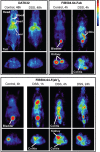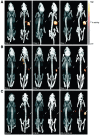Monoclonal antibody-based molecular imaging strategies and theranostic opportunities
- PMID: 31903161
- PMCID: PMC6929980
- DOI: 10.7150/thno.37443
Monoclonal antibody-based molecular imaging strategies and theranostic opportunities
Abstract
Molecular imaging modalities hold great potential as less invasive techniques for diagnosis and management of various diseases. Molecular imaging combines imaging agents with targeting moieties to specifically image diseased sites in the body. Monoclonal antibodies (mAbs) have become increasingly popular as novel therapeutics against a variety of diseases due to their specificity, affinity and serum stability. Because of the same properties, mAbs are also exploited in molecular imaging to target imaging agents such as radionuclides to the cell of interest in vivo. Many studies investigated the use of mAb-targeted imaging for a variety of purposes, for instance to monitor disease progression and to predict response to a specific therapeutic agent. Herein, we highlighted the application of mAb-targeted imaging in three different types of pathologies: autoimmune diseases, oncology and cardiovascular diseases. We also described the potential of molecular imaging strategies in theranostics and precision medicine. Due to the nearly infinite repertoire of mAbs, molecular imaging can change the future of modern medicine by revolutionizing diagnostics and response prediction in practically any disease.
Keywords: autoimmune diseases; molecular imaging; monoclonal antibodies; oncology and cardiovascular diseases..
© The author(s).
Conflict of interest statement
Competing Interests: The authors have declared that no competing interest exists.
Figures



Similar articles
-
Monoclonal Antibodies: A Review.Curr Clin Pharmacol. 2018;13(2):85-99. doi: 10.2174/1574884712666170809124728. Curr Clin Pharmacol. 2018. PMID: 28799485 Review.
-
Theranostics and metabolotheranostics for precision medicine in oncology.J Magn Reson. 2018 Jun;291:141-151. doi: 10.1016/j.jmr.2018.03.004. Epub 2018 Apr 26. J Magn Reson. 2018. PMID: 29705040 Free PMC article. Review.
-
Theranostics Using Antibodies and Antibody-Related Therapeutics.J Nucl Med. 2017 Sep;58(Suppl 2):83S-90S. doi: 10.2967/jnumed.116.186940. J Nucl Med. 2017. PMID: 28864618 Review.
-
Molecular imaging in nuclear cardiology: Pathways to individual precision medicine.J Nucl Cardiol. 2020 Dec;27(6):2195-2201. doi: 10.1007/s12350-020-02319-6. Epub 2020 Sep 6. J Nucl Cardiol. 2020. PMID: 32893320 Free PMC article. Review.
-
Less Exploited GPCRs in Precision Medicine: Targets for Molecular Imaging and Theranostics.Molecules. 2018 Dec 23;24(1):49. doi: 10.3390/molecules24010049. Molecules. 2018. PMID: 30583594 Free PMC article. Review.
Cited by
-
Imaging of Heart Type Fatty Acid Binding Protein Under Acute Reperfusion Ischemia Using Radio-labeled Antibody in Rat Heart Model.Ann Nucl Cardiol. 2022;8(1):14-20. doi: 10.17996/anc.21-00146. Epub 2022 Aug 31. Ann Nucl Cardiol. 2022. PMID: 36540183 Free PMC article.
-
EGFR-Targeted Perfluorohexane Nanodroplets for Molecular Ultrasound Imaging.Nanomaterials (Basel). 2022 Jun 30;12(13):2251. doi: 10.3390/nano12132251. Nanomaterials (Basel). 2022. PMID: 35808089 Free PMC article.
-
Targeted PET/MRI Imaging Super Probes: A Critical Review of Opportunities and Challenges.Int J Nanomedicine. 2022 Jan 1;16:8465-8483. doi: 10.2147/IJN.S336299. eCollection 2021. Int J Nanomedicine. 2022. PMID: 35002239 Free PMC article. Review.
-
Emerging biomedical imaging-based companion diagnostics for precision medicine.iScience. 2023 Jul 3;26(8):107277. doi: 10.1016/j.isci.2023.107277. eCollection 2023 Aug 18. iScience. 2023. PMID: 37520706 Free PMC article. Review.
-
Multiple Tolerization Subtractive Immunization (MTSI) Protocol: Effects on Mice and Monoclonal Antibody Specificity.Front Immunol. 2021 Dec 7;12:760817. doi: 10.3389/fimmu.2021.760817. eCollection 2021. Front Immunol. 2021. PMID: 34950138 Free PMC article.
References
Publication types
MeSH terms
Substances
LinkOut - more resources
Full Text Sources
Other Literature Sources
Medical

